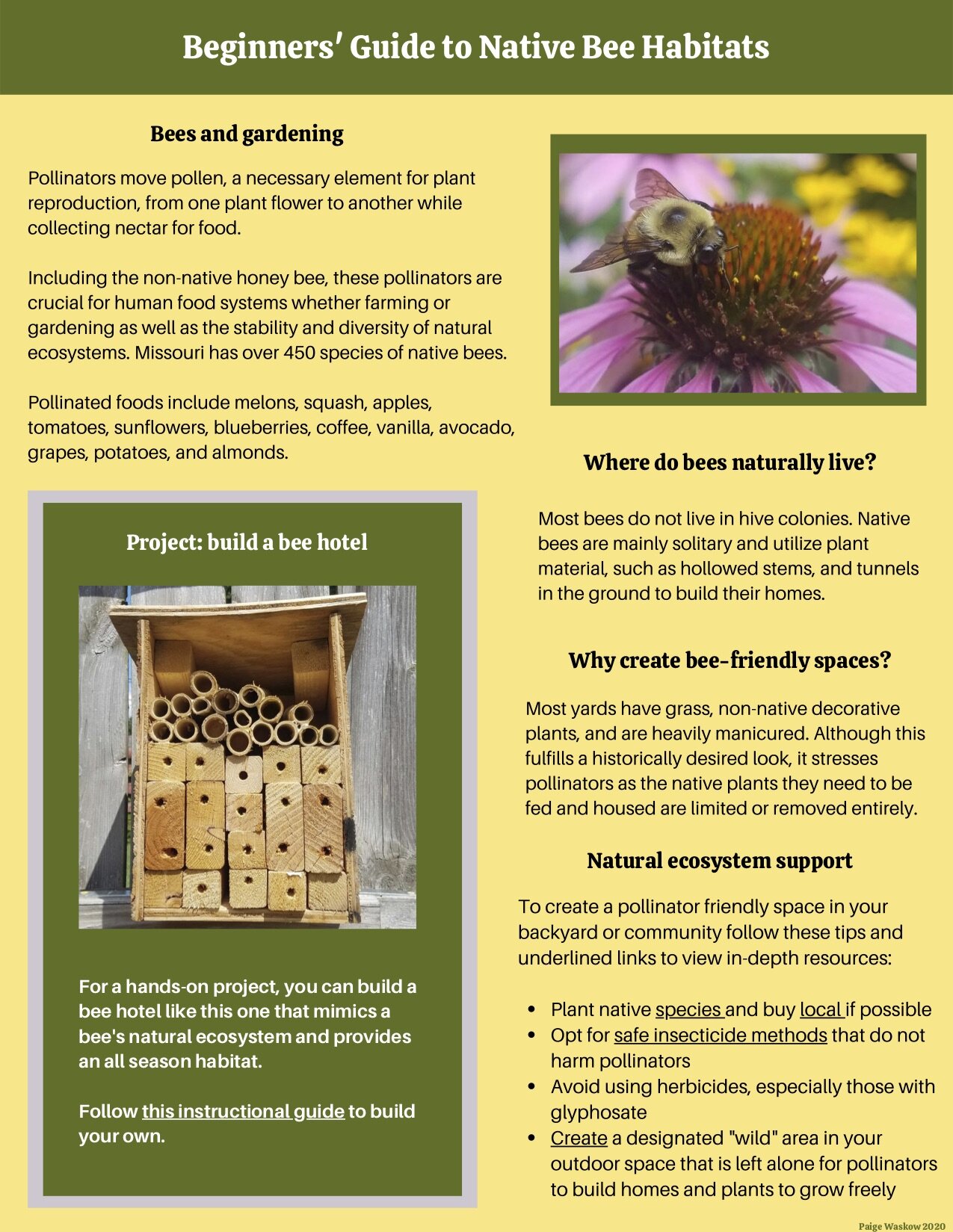Beginner's Guide to Native Bee Habitats
Learn about the benefits of planting native flowers and some common examples!
Food Preservation Through a Culinary Justice Lens
Learn the basics of culinary justice, why it matters to urban growers, and some simple preservation methods to try yourself.
By Briana Robles, Leadership in Urban Agriculture Internship, Summer II 2020
Photo by Soul Fire Farm.
Introduction to Culinary Justice
Co-executive director of Soul Fire Farm and author of Farming While Black, Leah Penniman, eloquently stated that “our tables are healing tables, fellowship tables, and living history tables.” Likewise, our tables are also rooted in food apartheid, which presents itself in statistics such as “1 in 4 black children go to bed hungry” and the common illusion that “healthy cooking and food preservation is a ‘white people thing.’” Michael Twitty, Culinary Historian and author of The Cooking Gene, defines culinary justice as “the idea that oppressed peoples have the right to not only be recognized for their gastronomic contributions, but they have the right to their inherent value… to derive from them, uplift and empowerment.”
Why Culinary Justice Matters to urban growers
As gardeners, farmers, and foodies, we participate with the food system in inherently distinct ways. Growing, preserving, cooking, and feasting are ways of honoring generational wisdom and living sustainably for the sake of those who will come after us. Chef Kabui, a Kenyan chef committed to decolonizing our food, reminds us that “everyone has a farming history in growing and preparing food. So, find it. Connect with it- with that ancestor. Carry it on.” Growing food invites us to grow in awareness of our land, ourselves, and one another.
Basic Methods of Food Preservation
Farming While Black mentions various methods for cooking and preserving the food we grow including, preserving in soil and ash, Drying, Fermentation, In-Vinegar, Canning, and Freezing. Below, Fermentation and In-Vinegar food preservation techniques will be discussed, and example recipes will be provided. To learn more about other indigenous ways of preserving food from around the world, click here.
PRESERVATION BY FERMENTATION
Fermentation is a method of food preservation used throughout the world that increases the nutritional content of food with the help of bacteria.
Veggies that are great candidates for beginner lactic acid fermentation include:
Cabbage (below)
Turnips
Carrots
Cucumbers
Radishes
Green beans
Photo by Emet Vitale-Penniman for Farming While Black.
HOW TO MAKE FERMENTED CABBAGE
Recipe adapted from Farming While Black by Leah Penniman
Slice cabbage thinly
Combine with non-iodized sea salt at a ratio of 1-pound vegetable to 1-teaspoon salt.
Use your hands to massage the salt into the cabbage
Let it sit in brine while you sterilize the canning jars* in boiling water
*NOTE: Standard quart-sized canning jars holds about 2 pounds of vegetable
Pack brined cabbage tightly into jars pressing out air as you go, so that the cabbage fills the jar up to the bottom of the rim
Pour liquid brine over cabbage to completely fill jar
Place lid on loosely
Arrange jars on tray/pan/dish & place at room temperature* for 3 days
*NOTE: The hard-working bacteria will result in bubbling and loss of liquid
Top off each jar with brine solution of 1-teaspoon of salt per 4 cups of water
Secure lids on tightly & transfer to cool/ dark refrigerator or basement
Bonus: Recipe can be jazzed up using garlic, dill, mustard seeds, caraway seeds, juniper berries, & other spices.
PRESERVATION IN VINEGAR
In about 2030 B.C, vinegar was first documented for the preservation of cucumbers in Mesopotamia near the Tigris River. Below, is a recipe for Pikliz, a sour & spicy staple in creole cuisine and every Haitian household.
Photo by Andrew Scrivani for The New York Times.
HOW TO MAKE PIKLIZ
Recipe adapted from Farming While Black by Leah Penniman
Thinly chop cabbage, carrots, & onions
Pack into clean jar
Add distilled vinegar to just cover the mixture
Add spices: thyme, whole cloves, lime juice, salt, & hot peppers
Cover with lid and shake
Allow to sit at room temperature for 3 days before consuming
*NOTE: Always use a clean spoon every time you add Pikliz to your meal
Bonus: Experiment by adding other veggies including, cucumber, sweet peppers, turnips, cooked beets, green peas, fennel, radish, cauliflower, green beans, & boiled eggs.
Additional Resources you might be interested in…
To learn more about Karen Washington, who coined the term “food apartheid”, click here.
To watch a short video by Michael Twitty on Culinary Justice, click here.
To read an interview with Sioux Chef Oglala Lakota about decolonizing our diet, click here.
Works Cited
Andrew Scrivani. “Pikliz”. To view, https://cooking.nytimes.com/recipes/1017277-pikliz.
Ecks Ecks. "Cabbage". Licensed under CC BY-NC-ND 2.0. To view a copy of this license, visit https://creativecommons.org/licenses/by-nc-nd/2.0/.
Penniman, Leah, and Karen Washington. Farming While Black: Soul Fire Farm's Practical Guide to Liberation on the Land. Chelsea Green Publishing, 2018.
Twitty, Michael. “Gastronomy and the social justice reality of food”. YouTube, uploaded by TED Archives, 20, Dec. 2016. https://youtu.be/8MElzoJ2L6U.
Vitale-Penniman, Emet. The author grates cabbage on a mandolin as an initial step in fermentation. 2018. Photograph. Farming While Black: Soul Fire Farm's Practical Guide to Liberation on the Land. Whit River City Junction, Vermont: Chelsea Green Publishing, 2018. 239. Print.
Beginner’s Guide to Reading a Fertilizer Label
Confused about the numbers on the outside of a fertilizer bag? Not sure which one to purchase? This helpful guide breaks it down!
By Melanie Moser, Leadership in Urban Agriculture Internship, Summer I 2020
When farming, it’s vital to know what nutrients different plants need to thrive. All plants need three main elements to grow to their full potential- Nitrogen (N), Phosphorous (P), and Potassium (K). Fertilizer bags list these three ingredients prominently on the label with three numbers. For example, a fertilizer with an NPK number of 10-10-10 has equal parts Nitrogen, Phosphorous, and Potassium. Each of these elements are used by the plant in different ways, which will be discussed in depth below. But if your plants are underproducing or unhealthy, employing fertilizer could be just what the gardener ordered!
Soils (urban or otherwise) frequently lack these three important nutrients. But urban farmers need to pay special attention to fertilizing. In the urban setting, farmers are often bringing in soil ingredients or building garden beds from scratch. The soil in a city plot may be particularly devoid of nutrients due to pollutants, overdevelopment, or neglect. In this case, nutrients can be put back into the soil to ensure healthy and productive plants.
Store bought fertilizers often have more ingredients than NPK, which are listed in the ingredient label, but those elements comprise a much smaller percentage. When reading the NPK number, pay attention to the ratio of the three numbers, remembering that the numbers refer to a percentage of the whole.. The highest number in the ratio is funneling nutrients to promote a specific type of growth. Here’s the breakdown:
Nitrogen- Involved in many processes, but plays a vital role in photosynthesis. Often associated with big leafy growth. If you have too much Nitrogen, plants can get strong foliage, but not flower or fruit. Lawn fertilizer (pictured below) is very Nitrogen heavy because foliage is the goal. That being said, if a lawn doesn’t have healthy roots, it won’t do well during dry spells or over the long run. Vegetable garden fertilizer does not need nearly as much Nitrogen. Some additional sources of Nitrogen are manure, compost, blood meal, and feather meal. Another popular method is called “cover cropping.” At Urban Harvest St. Louis, farmers use this technique by cutting legumes and clovers down at the base after harvesting, leaving the root structure to decay in the soil. The legumes then release Nitrogen into the soil through their root nodules. This helps to stabilize the Nitrogen level for other plants that come next in the growing season.
Phosphorous- Plays a role in many of the basic plant functions- root growth, structural strength, flower and seed production. Without Phosphorus, plants will not reach their potential. Phosphorus can be found in phosphate rock, manure, compost, blood meal, and bone meal.
Potassium- Referred to as “the quality element” because it contributes to size, shape, color, and taste. A plant with a potassium deficiency is stunted and has lower yields. Sources of potassium include manure, compost, wood ash, and potash.
While it may seem complicated, I have found it quite effective to apply a standard organic 10-10-10 fertilizer consistently through the growing season. This is in addition to a yearly application of compost. In my home garden setting, this seems to do the trick. Before I studied fertilizer, I simply added compost. One year my peppers flowered, but didn’t fruit. Now I know that was due to a Phosphorous deficiency! A friend of mine just started his first garden and his seedlings never got off the ground. He felt he was growing a miniature garden. It’s clear his soil most likely needs more of all three- NPK. So, you know what they say. If you want to have a veggie Partay, it’s N.P.K.!
Additional Resources
https://feeco.com/npk-fertilizer-what-is-it-and-how-does-it-work/
A Brief Guide to Native Planting in Missouri
Learn about the benefits of planting native flowers and some common examples!







